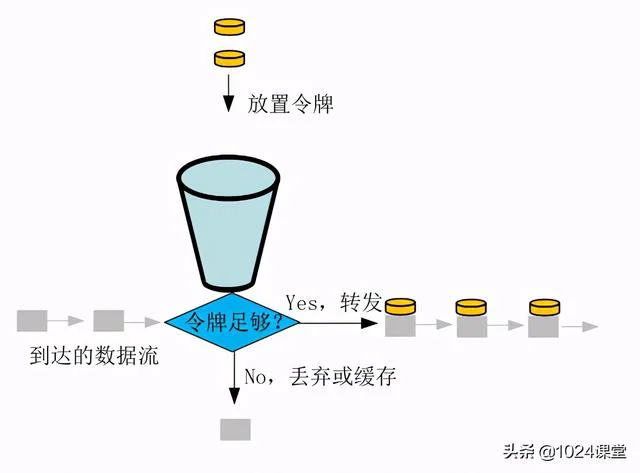从这篇文章开始会开始讲一讲限流该如何做,会结合 Go 进阶训练营 中的内容、网上查阅的一些资料以及个人一些微小的经验进行总结,这一部分预计总共会有 7 篇文章,今天我们来开始第一篇,令牌桶的原理及使用。
令牌桶原理
如上图[5] 所示,令牌桶的大概原理是:
我们以 r/s 的速度向桶内放置令牌,桶的容量为 b , 如果桶满了令牌将会丢弃当请求到达时,我们向桶内获取令牌,如果令牌足够,我们就通过转发请求如果桶内的令牌数量不够,那么这个请求会被缓存等待令牌足够时转发,或者是被直接丢弃掉由于桶的存在,所以令牌桶算法不仅可以限流还可以应对突发流量的情况
举个例子:假设我们桶的容量是 100,速度是 10 rps,那么在我们桶满的情况下,如果突然来 100 个请求是可以满足的,但是后续的请求就会被限制到 10 rps
存在下面两种特殊情况
如果桶的容量为 0,那么相当于禁止请求,因为所有的令牌都被丢弃了如果令牌放置速率为无穷大,那么相当于没有限制令牌桶最常见的实现就是 Go 官方的 golang.org/x/time/rate,接下来我们就看看这个库如何使用吧
使用方法方法一览// 限流器结构体type Limiter // 构建一个限流器,r 是每秒放入的令牌数量,b 是桶的大小 func NewLimiter(r Limit, b int) *Limiter // 分别返回 b 和 r 的值 func (lim *Limiter) Burst() int func (lim *Limiter) Limit() Limit // token 消费方法 func (lim *Limiter) Allow() bool func (lim *Limiter) AllowN(now time.Time, n int) bool func (lim *Limiter) Reserve() *Reservation func (lim *Limiter) ReserveN(now time.Time, n int) *Reservation func (lim *Limiter) Wait(ctx context.Context) (err error) func (lim *Limiter) WaitN(ctx context.Context, n int) (err error) // 动态流控 func (lim *Limiter) SetBurst(newBurst int) func (lim *Limiter) SetBurstAt(now time.Time, newBurst int) func (lim *Limiter) SetLimit(newLimit Limit) func (lim *Limiter) SetLimitAt(now time.Time, newLimit Limit)初始化令牌桶
直接调用 NewLimiter(r Limit, b int) 即可, r 表示每秒产生 token 的速度, b 表示桶的大小
Token 消费总共有三种 token 消费的方式,最常用的是使用 Wait 阻塞等待**Allow
Allow 就是 AllowN(now,1) 的别名, AllowN 表示截止到 now 这个时间点,是否存在 n 个 token,如果存在那么就返回 true 反之返回 false,如果我们限流比较严格,没有资源就直接丢弃可以使用这个方法。
func (lim *Limiter) Allow() boolfunc (lim *Limiter) AllowN(now time.Time, n int) bool
同理 Reserve 也是 ReserveN(now, 1) 的别名, ReserveN 其实和 AllowN 类似,表示截止到 now 这个时间点,是否存在 n 个 token,只是 AllowN 直接返回 true or false,但是 ReserveN 返回一个 Reservation 对象
func (lim *Limiter) Reserve() *Reservationfunc (lim *Limiter) ReserveN(now time.Time, n int) *Reservation
Reservation 有 5 个方法,通过调用 OK 我们可以知道是否通过等待可以获取到 N 个 token,如果可以通过 Delay 方法我们可以得知需要等待的时间,如果我们不想等了可以调用 Cancel 方法归还 token
type Reservation func (r *Reservation) Cancel() func (r *Reservation) CancelAt(now time.Time) func (r *Reservation) Delay() time.Duration func (r *Reservation) DelayFrom(now time.Time) time.Duration func (r *Reservation) OK() bool
Wait 是最常用的, Wait 是 WaitN(ctx, 1) 的别名, WaitN(ctx, n) 表示如果存在 n 个令牌就直接转发,不存在我们就等,等待存在为止,传入的 ctx 的 Deadline 就是等待的 Deadline
func (lim *Limiter) Wait(ctx context.Context) (err error)func (lim *Limiter) WaitN(ctx context.Context, n int) (err error)动态流控
通过调用 SetBurst 和 SetLimit 可以动态的设置桶的大小和 token 生产速率,其中 SetBurstAt 和 SetLimitAt 会将传入的时间 now 设置为流控最后的更新时间
func (lim *Limiter) SetBurst(newBurst int)func (lim *Limiter) SetBurstAt(now time.Time, newBurst int)func (lim *Limiter) SetLimit(newLimit Limit)func (lim *Limiter) SetLimitAt(now time.Time, newLimit Limit)案例: 10 行代码实现 基于 ip 的 gin 限流中间件
正好上周我们有个类似的需求,我们就来简单实现一下,其实主要就是使用了 sync.map 来为每一个 ip 创建一个 limiter,当然这个 key 也可以是其他的值,例如用户名等
func NewLimiter(r rate.Limit, b int, t time.Duration) gin.HandlerFunc { limiters := &sync.Map{} return func(c *gin.Context) { // 获取限速器 // key 除了 ip 之外也可以是其他的,例如 header,user name 等 key := c.ClientIP() l, _ := limiters.LoadOrStore(key, rate.NewLimiter(r, b)) // 这里注意不要直接使用 gin 的 context 默认是没有超时时间的 ctx, cancel := context.WithTimeout(c, t) defer cancel() if err := l.(*rate.Limiter).Wait(ctx); err != nil { // 这里先不处理日志了,如果返回错误就直接 429 c.AbortWithStatusJSON(http.StatusTooManyRequests, gin.H{"error": err}) } c.Next() }}使用的时候只需要 use 一下中间件就可以了
func main() { e := gin.Default() // 新建一个限速器,允许突发 10 个并发,限速 3rps,超过 500ms 就不再等待 e.Use(NewLimiter(3, 10, 500*time.Millisecond)) e.GET("ping", func(c *gin.Context) { c.String(http.StatusOK, "pong") }) e.Run(":8080")}我们使用 go-stress-testing 来压测一下,20 个并发
可以发现总共成功了 11 个请求,失败了 9 个,这是因为我们桶的大小是 10 所以前 10 个请求都很快就结束了,第 11 个请求等待 333.3 ms 就可以完成,小于超时时间 500ms,所以可以放行,但是后面的请求确是等不了了,所以就都失败了,并且可以看到最后一个成功的请求的耗时为 336.83591ms 而其他的请求耗时都很短
[GIN-debug] Listening and serving HTTP on :8080[GIN] 2021/03/29 - 13:15:55 | 200 | 1.48104ms | 127.0.0.1 | GET "/ping"[GIN] 2021/03/29 - 13:15:55 | 429 | 1.107689ms | 127.0.0.1 | GET "/ping"[GIN] 2021/03/29 - 13:15:55 | 429 | 1.746222ms | 127.0.0.1 | GET "/ping"[GIN] 2021/03/29 - 13:15:55 | 429 | 866.35µs | 127.0.0.1 | GET "/ping"[GIN] 2021/03/29 - 13:15:55 | 429 | 1.870403ms | 127.0.0.1 | GET "/ping"[GIN] 2021/03/29 - 13:15:55 | 429 | 2.231912ms | 127.0.0.1 | GET "/ping"[GIN] 2021/03/29 - 13:15:55 | 429 | 1.832506ms | 127.0.0.1 | GET "/ping"[GIN] 2021/03/29 - 13:15:55 | 429 | 613.741µs | 127.0.0.1 | GET "/ping"[GIN] 2021/03/29 - 13:15:55 | 200 | 1.454753ms | 127.0.0.1 | GET "/ping"[GIN] 2021/03/29 - 13:15:55 | 200 | 1.37802ms | 127.0.0.1 | GET "/ping"[GIN] 2021/03/29 - 13:15:55 | 200 | 1.428062ms | 127.0.0.1 | GET "/ping"[GIN] 2021/03/29 - 13:15:55 | 200 | 40.782µs | 127.0.0.1 | GET "/ping"[GIN] 2021/03/29 - 13:15:55 | 200 | 1.046146ms | 127.0.0.1 | GET "/ping"[GIN] 2021/03/29 - 13:15:55 | 429 | 1.7624ms | 127.0.0.1 | GET "/ping"[GIN] 2021/03/29 - 13:15:55 | 429 | 1.803124ms | 127.0.0.1 | GET "/ping"[GIN] 2021/03/29 - 13:15:55 | 200 | 41.67µs | 127.0.0.1 | GET "/ping"[GIN] 2021/03/29 - 13:15:55 | 200 | 1.42315ms | 127.0.0.1 | GET "/ping"[GIN] 2021/03/29 - 13:15:55 | 200 | 1.371483ms | 127.0.0.1 | GET "/ping"[GIN] 2021/03/29 - 13:15:55 | 200 | 731.091µs | 127.0.0.1 | GET "/ping"[GIN] 2021/03/29 - 13:15:55 | 200 | 336.83591ms | 127.0.0.1 | GET "/ping"总结
这篇主要介绍了一下令牌桶的实现原理,以及 Go 官方实现如何使用,最后讲了一个使用案例,下一篇我们再来学习一下源码是怎么实现的
